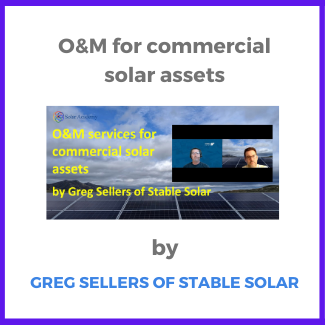Greg Sellers of Stable Solar brings us all you need to know about operations and maintenance (O&M) on a commercial solar system. He talks about the similarities with resi systems, the DIY approach and also covers what an O&M business can offer when it comes to keeping a commercial solar system in top shape. Watch the 5 min video.
Here’s the video transcript.
Solar Academy: Hi, everyone, this is Kerim Baran with Solar Academy. I have Greg Sellers with Stable Solar with me again this week. Greg, let’s talk a little bit about commercial solar. I know Stable Solar’s main area of focus has been servicing residential solar systems for homeowners from an O&M perspective, an operations and maintenance of residential solar. But another segment that you serve is the commercial segment. So can you talk a little bit about solar assets in the context of commercial entities and what are their main needs? And how do you help them?
Sellers: Yeah, I think for us, we see commercial systems as an extension of residential for smaller in particular. In the industry they lump C&I together, commercial and industrial. Industrial is a whole different entity – larger entities that are completely autonomous and reside on massive amounts of land or completely different infrastructure. But smaller to medium sized commercial, and certainly anything under 100 kilowatts, really anything under 250 kW uses largely the same infrastructure. And it really has the same components, just more of them.
In fact this week, coincidentally, I was on a roof of a commercial structure, and there were multiple arrays, three or four of them, and they each one had between 20 and 35 or 40 panels. And that basically, is what you’d see on a residential system only, you’d see 20 panels, 25 total. So the basic infrastructure is really identical. But where we were helpful is largely the same, which is maintaining, keeping an eye on the system and maintaining it, making sure that it’s providing the amount of power that we’re expecting of it.
With commercial because of the way it’s financed and also, because of the implications for the entity that is using the power, you need to be a little more diligent in terms of keeping a close eye on the system, because the variations can make a bigger impact. But otherwise, it’s very much the same.
One of the things that we do actually, interestingly, and even though it’s February, I was looking at a system in California. It was surprising, well, not really surprising. But it was surprising how much dust accumulated and dirt had accumulated on the system. It was a flat rooftop solar installation. So we were able to stand easily next to the panels and take a look. We talked to the manager about exactly how we would go about doing cleaning.
And just like residential, you can either clean it yourself, there’s a few quick things I can go over that enable you to do that. But there’s also entities that can can go out and do it for relatively inexpensive. We certainly do a lot of those and other folks that we work with do as well, to just go out a couple times a year and just clean them off and make sure they’re they’re doing what they’re supposed to.
If you’re doing it yourself, whether you’re a residential owner or commercial, the main things we always mention is to do it during the cold time of the day. Do not go out there and put water on a panel when it’s very hot out, probably for obvious reasons. But you don’t want those impacts. Try to use the ionized water. And use a soft scrub, a soft cloth, they usually have at Home Depot and other places. They’ll sell soft cloth that you can use to make sure you’re not scratching the glass. And really you just want to make sure that you eliminate streaks as much as possible.
When you’re done, get the main dirt off of it and get make sure you get the dirt off the entire panel. If you end up with accumulation on the bottom, it’ll impact those cells and sometimes the entire panel itself or the array if they’re not done properly. So make sure you get all the dirt off of them.
But those are the kinds of things that we look at – just one of the many things that we try to focus on to make sure that the systems are doing what they’re supposed to. We do commercial. We think the small to medium commercial, like I say, is very similar in terms of the O&M world to residential and with the same issues for cleaning to failures of equipment and other things. So it’s exciting and interesting for us and we look forward to doing more of the commercial just like we’re doing more residential.
Solar Academy: Great. Thank you very much.


